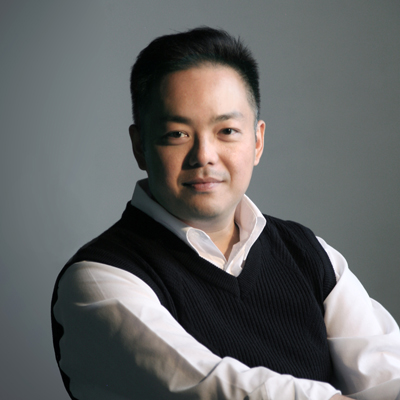
李子勋(Lee Tzu-hsun)
简历
李子勋 Lee Tzu-hsun
1973 出生于台湾台北
2003 德国杜塞尔多夫艺术学院毕业
1995—2009 旅居德国
现今生活及工作在中国北京
展览
2016 「AZZ艺术郑州·2016‘全球中国’当代艺术展」,绿地中心,郑州,中国
2015 「我想要做一个梦」,台北市立美术馆,台北,台湾
2015 「制心一處」,居然頂層設計中心 ,中國北京
2015 「台湾青年艺术典藏展」,台湾美术馆,台中,台湾
2014 「剪刀 & 石頭 & 布–青年藝術家聯展」, 宋莊美術館,中國北京
2014 「"瞬间"展示的空间 - 昌原亚洲艺术节」,城山艺术厅,昌原,韩国
2013 「北京之声-我的伙伴」,佩斯北京,中国北京
2013 「标新·立意 - 青年艺术家作品展」,台湾美术馆,台中,台湾
2013 「脸颊书写」,诚品画廊 , 台北,台湾
2012 「李子勋」个展,佩斯北京,北京,中国
2010 「跨越时空 - 淄博学院国际邀请展」, 淄博职业学院,山东,中国
2010 「世纪聚合 - 七国艺术家展」, 驻华韩国文化院,北京,中国
2009 「生化·虚实之间 - 动漫美学双年展」,今日美术馆,北京,中国
2009 「动漫美学百相」,林大画廊,北京,中国
2008 「梦蝶 - 上海当代艺术馆文献展Ⅱ」,上海当代艺术馆,上海,中国
2008 「漫天动海」,林大画廊,上海,中国
2008 「驱动 & 控制的艺术 – 操纵、动态、推动的魅力」,IHK - Bosch Rexroth 公司
福斯堡,德国
2007 「从现代性到永恆 - 动漫美学双年展 」,上海当代艺术馆,上海,中国
2007 「绿野仙纵 - 台湾当代艺术的奇想世界」,台湾美术馆,台中,台湾
2007 「ANIMANGA - EXIT 国际艺术节」,克泰艺术馆,巴黎,法国
2007 「ANIMANGA - VIA 国际艺术节」,蒙柏许综合文艺厅,蒙柏许,法国
2007 「XXX - 女飞官」,三一教堂,科隆,德国
2006 「人体·虚拟乐园 - 台湾美术馆艺术典藏展」,台湾美术馆,台中,台湾
2006 「斐特列·浮登贝格奖」双个展,科隆艺术家协会,科隆,德国
2006 「诚品之翼」,诚品画廊,台北,台湾
2006 「用图形表现的样态」,Gloriahalle , 杜塞道夫,德国
2005 「进行中的机械对话」个展,原型艺术实验室,科隆,德国
2005 「第七届科隆艺术展」,科隆 Carré,科隆,德国
2005 「E术诞生 - 台湾艺术新秀展」,台湾美术馆,台中,台湾
2005 「后石器时代 - 台湾当代年轻艺术家特展」,台北世贸中心展览馆三馆,台北 ,台湾
2004 「玻璃珠游戏的秘密」个展,诚品画廊,台北,台湾
2004 「虚拟的爱 - 当代新异术」,台北当代艺术馆,台北,台湾
2004 「正言世代 - 台湾当代视觉文化」,康乃尔大学/赫柏特 F·約翰遜美术馆
纽约,美国
2004 「三放」苏州人文艺术会馆,苏州
2003 「亚洲艺术力量」,Revolver 画廊,杜塞道夫,德国
2003 「物体和雕塑」,哥特斯洛艺术协会,哥特斯洛;Oberkassel 艺术中心
杜塞道夫,德国
2003 「节目预告」,Schön画廊,波洪,德国
2002 「世界剧场 - 2002台北双年展」,台北市立美术馆,台北,台湾
2002 「欢乐迷宫 - 再现童年」,高雄市立美术馆,高雄,台湾
2001 「Campus Thermal」,圣雷杰公园当代艺术中心,桑特侬西,法国
2001 「製造爱情的过程」实验剧,杜塞道夫艺术学院 - Raum 011,杜塞道夫,德国
2001 「欢乐迷宫 - 再现童年」,台北当代艺术馆,台北,台湾
2000 「疯人院联展」,Artoll实验室,彼得堡,德国
2000 「第54届巴登美术馆艺术展」,巴登美术馆,舒林恩,德国
2000 「複数元的视野 - 台湾当代美术1988—1999」,高雄山美术馆、新竹清华大学艺术中心
高雄山美术馆,新竹清华大学艺术中心,台湾
1999 「In de ban van de ring」,毕根豪夫省立美术馆,哈塞特,比利时
1999 「爱情殿堂」,杜塞道夫艺术博览会,杜塞道夫,德国
1999 「複数元的视野 - 台湾当代美术1988—1999」,中国美术馆,北京、台北历史博物馆
台北, 台湾
1998 「大鱼」双个展,杜塞道夫艺术学院 .Raum 013,杜塞道夫,德国
1997 「结馀」,杜塞道夫大宫美术馆,杜塞道夫,德国
1994 「貌合神离」,台北绘画欣赏协会,台北,台湾
1992 「聚合一刻」,天恩画廊,永和,台湾
奖项
2007 德国 Bosch Rexroth 公司–艺术奖
2006 德国科隆市政府–斐特列·浮登贝格奖学金
2000 德国巴登美术馆第54届艺术展–最受欢迎奖
1999 德国杜塞道夫艺术学院–旅游奖学金
艺术家作品
▼ 异星人飞行器 系列
Mechanical Aesthetics

水星人飞行器 2007
Mercurial Spacecraft
综合媒材 Mixed media
112 x 150 x 38 cm

"异星人飞行器" 系列发表於佩斯北京的个展现场
Solo Exhibition "Mechanical Aesthetics" at the Pace Beijing, China

迷惑的潘朵拉 2008
Pandora at a loss
综合媒材 Mixed media
300 x 300 x 160 cm

天王星飞行器 1 号 2 0 1 1
Uranian Spacecraft No. 1
综合媒材 Mixed media
240 x 214 x 26 cm
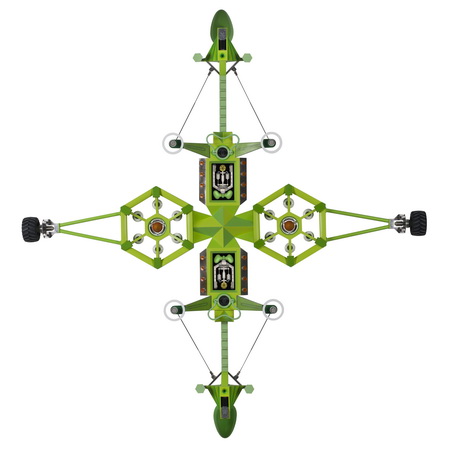
天王星飞行器 2 号 2 0 1 1
Uranian Spacecraft No. 2
综合媒材 Mixed media
240 x 214 x 26 cm

天王星飞行器 2 号–於墙面 360°动态旋转
Uranian Aircraft No. 2–rotating 360°
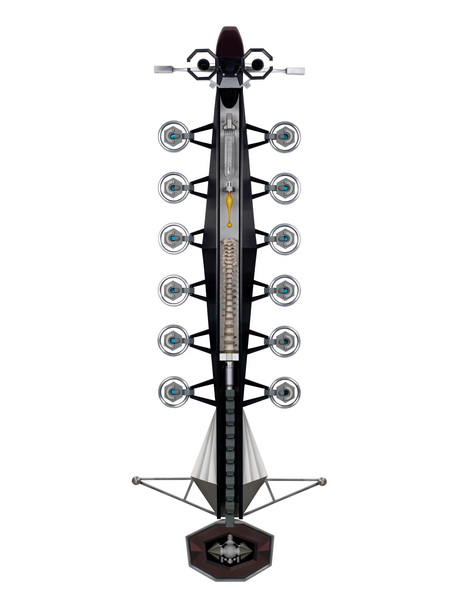
冥王星飞行器 2 号 2 0 1 2
Plutonian Spacecraft No. 2
综合媒材 Mixed media

金星飞行器 2 号 2 0 1 1
Venusian Spacecraft No. 2
综合媒材 Mixed media
151 x 151 x 48 cm
( 管状物向外延伸135cm Plastic tube extension: length 135 cm)

金星飞行器 2 号– 局部
Venusian Aircraft No. 2 – partial
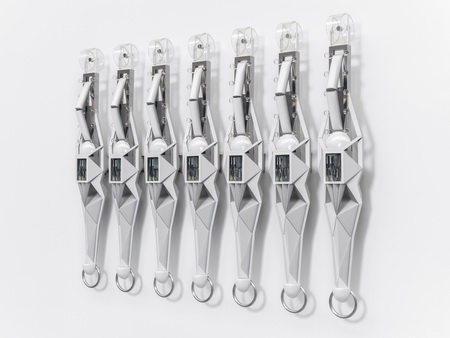
序列式飞行器1号 2013
Sequential Spacecraft No.1
综合媒材 Mixed media
178 x 135 x 8.5 cm
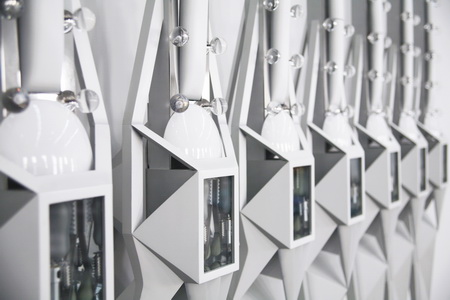
序列式飞行器1号 – 局部
Sequential Spacecraft No.1 – partial view
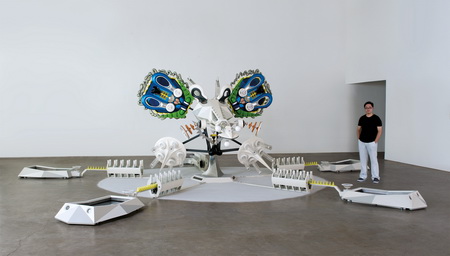
机械灵魂 2010
Mechanical Soul
综合媒材 Mixed media

机械灵魂 – 局部
Mechanical Soul – partial view

机械灵魂 – 播放 3D 製作影像的液晶频幕
Mechanical Soul – LCD displays that showing 3D animation

机械灵魂 – 后侧
Mechanical Soul – rear view
异星人飞行器 系列
机械美学
——建构的和谐宇宙秩序
见到李子勋的时候,言谈之间会觉得他像一个哲学家,有着自己的语言体系和细致的思维方式。他的作品严格追求整体的对称与统一,用极端的规则和物质材料去表达最无形的东西。乍听之下有点牵强,但在李子勋身上却显得特别自然。他就像一个同时走在两端的人,一方面,他全然任由作品框架内的构成要素自由变化,另一方面,他又希望可以完全掌控其中的任何一条构成规律,也许正是这样的固执和矛盾,为他的作品带来了无限的张力!
对于子勋而言,创作行为本身就像一场奋力朝向个人内在回归的探索。他作品中的形象结构、色彩掌控、材质选择,都与人的心理有对应的关系,他希望以此激荡人类灵魂对秩序与美的内在需要。因为他完全地相信,“那能看见的,是出于那不能看见的实体,外在的是出于内在的表现“。这使得他的创作透过探寻本源的严谨分析方式,将抽象的心灵结构转化成了一个充满秩序规律的世界; 艺术家的自由想像,也在此时空凝结成了由内在张力所构成的均衡形态,这即成为作品本身全部的内容!
李子勋近年来在佩斯北京所发表的《异星人飞行器》系列,以星体飞行器为命名的代号,将高度制作技术介入纯艺术形式中,相互融合,创造了一种介于生命体、无生命体之间的“仿生物“,其本身也是一种近似飞行器的机械动态雕塑。这是艺术家对未知事物的无限幻想,转化而成的艺术表现方式。李子勋对塑造内在信息世界再现有着理想化、秩序化的执着追求,由此他发展出一种独特的半抽象机械美学语言,并通过这种具结构性的有机形式,赋予作品一种和谐的内在秩序。
李子勋将拓展视觉艺术形态作为创作的动力,作品有效地融汇了雕塑、装置、建筑、影像的表达方式,加上他对特异材料和技术的研究探索,使他作品的形式变得更丰富多样。同时,藉由结合机械动态化和3D影像以及光的运用,他让作品在不同的运动瞬间呈现出不同的视觉状态。通过这种对新形式的塑造、声光动态和相异材料的组合实验,各原件渐进产生了一种微妙的衔接脉络,它们共同构筑一个整体系统,形成了他个人式的宇宙价值观。
李子勋偏好在构建作品的过程中,同时输入许多图像元素,先任其自由推演,再加以控制发展 ,令其最终成为一种外表复杂、精确的几何形式,而不同块面的相互融合构成新的和谐统一,在其中秩序与美均得以清楚显现。李子勋认为好的艺术应该是理性的,同时也是非理性的,并要达到两者的兼而容之。他曾说:“我不相信有个清楚分明的世界,因此一直对无法定义的形状感到着迷;理想上,这些东西引发了全新的复杂联想,而且无法清楚诠释,它们是“未曾经验过”和“不可知的”。我的创作兴趣总是始于对它们的研究分析、推敲和重组建构,而这就像是处在一个开放性的成长过程,永远没有终结地形塑一个新的世界”。
Alien Spacecraft Series
Mechanical Aesthetics
——The construct of a harmonious Universal order
LEE, Tzu-Hsun's Alien Spacecraft Series which was recently unveiled at Pace Beijing uses the spacecraft as a vehicle for injecting high production technology into pure art form, merging the two to produce a "miomimetic" body that is neither living nor lifeless. The body is a mechanical kinetic sculpture resembling an aircraft which represents the artist's infinite fantasies of unknown events and objects, as transformed into a mode of artistic expression. Lee, Tzu-Hsun has an idealized, ordered persistent pursuit of the internal informational world. From this point of departure, he develops a unique semi-abstract mechanical aesthetical lexicon, and through this structured organic form, he bestows a harmonious inner order onto his work.
For LEE, Tzu-Hsun, the act of creating is itself a struggle to explore an individual inner regression. In his works, structures of form, color control, and media selection have a corresponding relationship to human psychology. He aims to agitate an internal need for form and beauty in the human spirit. He firmly believes "that which can be seen emerges out of an unseen actuality; the external is an expression of the internal." This enables him to transform abstract spiritual structures in his works through a method of cautious analysis into a world that brims with order and regularity in his search for origin. In this temporal space, the artist’s freedom of imagination condenses itself into a balanced format constructed by internal tension, and this becomes the entire content of the work itself.
The expansion of visual art forms has become a creative momentum for LEE, Tzu-Hsun. In his works, he effectively integrates diverse modes of expression including sculpture, installation, architecture, and images. This, in addition to his research and exploration of specific materials and technologies, means that his work becomes even richer and more varied in form. At the same time, his applications of mechanical dynamics, three dimensional imaging, and lighting, fuse to create different visual states at each moment of operation. By experimenting and combining new constructed forms, light and sound dynamics, and disparate materials, each unit progressively produces a subtle context for convergence. They combine to construct a complete system, establishing a personal universal value system for LEE, Tzu-Hsun.
In the process of constructing his work, LEE, Tzu-Hsun prefers to inject a number of image elements, allowing these to be freely deduced before they are controlled and developed, and then ultimately becoming a precise geometric form with a sophisticated external appearance. This harmonious unity constructed by merging different blocks clearly displays an order and aesthetic within. LEE, Tzu-Hsun believes that good art is simultaneously rational and irrational, and must contain elements of both. He once said, "I don't believe in a world that is clear and distinct, and so I have always been captivated by undefined shapes. These objects inspire new and complex associations, but cannot be clearly explicated. They are 'that which has not been experienced' and 'unknowable.' My creative interests have always been in the study and analysis, the scrutinizing and restructuring of these elements. It is a growing process of total freedom, endlessly and infinitely constructing a new world.”
Conversationally, LEE, Tzu-Hsun comes across as a philosopher with his own language system and detailed method of contemplation. His works rigorously pursue an overall symmetry and unity, and attempt to apply intense regularity to physical materials in order to express that which is otherwise shapeless. This may sound far-fetched initially, but with LEE, Tzu-Hsun it seems completely natural. He seems to simultaneously exist on two extremes. On the one hand, he allows his work to transform freely within a main structural framework, and on the other hand, he aims to be in complete control over every rule constructed. Perhaps it is this insistence and paradox that brings a sense of boundless tension to his work.

